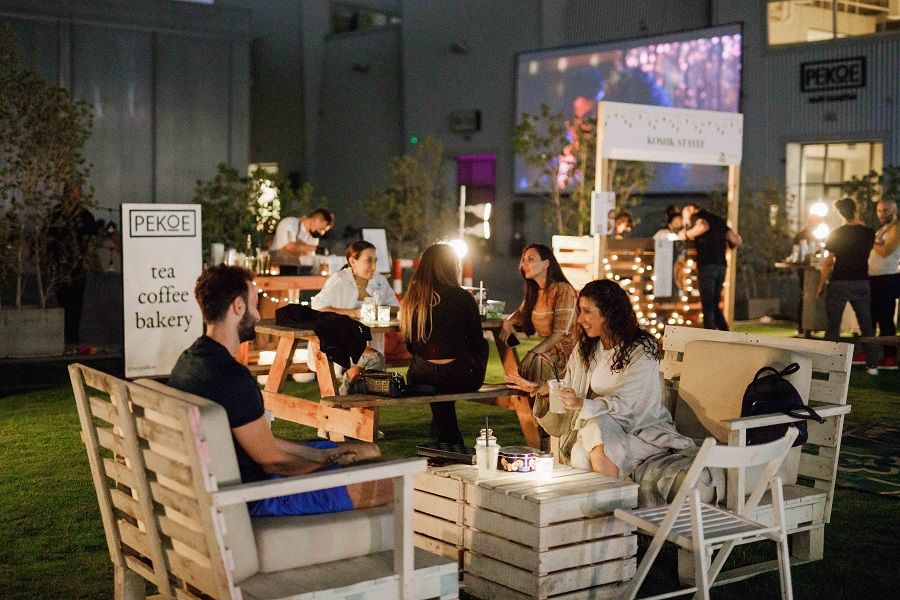The structure of the staircase is inclined at a 5° angle, a tilt that is just enough for someone to notice, but too small to be obvious, creating doubt when stepped on, a characteristic that’s recurring in Carsten’s work.
Andrea Tirali’s (around 1660–1737) Palazzo Diedo project remained incomplete due to the death of both the architect and the original owner. When Fassi architects; Silvio Fassi, Maddalena Gallamini and Sebastiano Roveroni, approached the restoration and design of Palazzo Diedo no stairs were connecting the first and second piano nobile. They decided to use the volume added in the 19th-century redesign, above the existing staircase of the 18th century, to connect the 2 main levels. Carsten Holler’s project to create a spiral staircase, inspired by the Venetian staircases of Palazzo Contarini del Bovolo and Palladio, fit into the space perfectly.

Photo by Massimo Pistore. Courtesy of the artist, Carsten Höller Studio and Palazzo Diedo
“Carsten Höller is famous for the slides he has built, but now he ventures into building an oval staircase. He must have had the Venetian staircases of Palazzo Contarini del Bovolo and Palladio in mind, but this one is inclined, like the city as a whole perhaps, or the human mind: how do we deal with verticality, and order in general, when the world we live in is everything but straight?” Baldo Hauser, 2024.
German artist Carsten Höller lives and works in Stockholm, Sweden, and Biriwa, Ghana. He has a doctorate in Agricultural Sciences, a knowledge of the scientific working method that he adopts in his artistic activity, although to subvert its basic rules. He conceives art as a cognitive tool and uses his works to transform the sensory and emotional experience of individuals, he wants to disorient and provoke the viewer, altering traditional perceptive mechanisms by creating situations and experiences, which instead of providing certainty instil doubt and make people lose their bearings.

Photo by Massimo Pistore. Courtesy of the artist, Carsten Höller Studio and Palazzo Diedo
Established by Berggruen Arts & Culture, a charitable foundation set up by collector and philanthropist Nicolas Berggruen, Palazzo Diedo is Venice’s first major new space dedicated to contemporary art for more than a decade. Janus, the inaugural exhibition curated by Mario Codognato, Director of Berggruen Arts & Culture and Adriana Rispoli, Curator of Berggruen Arts & Culture features site-specific commissions by 11 internationally acclaimed artists – Urs Fischer, Piero Golia, Carsten Höller, Ibrahim Mahama, Mariko Mori, Sterling Ruby, Jim Shaw, Hiroshi Sugimoto, Aya Takano, Lee Ufan and Liu Wei. It aims to deepen the connection between contemporary art and the past, and between East and West. It will host artist residencies, exhibitions, events, film and performance across five levels and a total area of 4,000 square metres.
About Palazzo Diedo
Over the last two years, Berggruen Arts & Culture has completed a major restoration of Palazzo Diedo, sympathetic to its history while readying it for a new beginning as a space of creativity and inspiration. Two significant fresco cycles and a Roman capricci—a scene that combines historical and fictional elements—by Francesco Fontebasso (1707-1769) and Costantino Cedini (1741-1811) have been fully restored. In 2022, Sterling Ruby presented the first project at Palazzo Diedo, a facade-based sculpture called HEX, installed before the completion of the restoration.
About Carsten Höller

Carsten Höller creates what he calls Influential Environments, intended to create particular states of mind, like excitement and alteration, doubt and confusion, joy and fear. Höller was born 1961 in Brussels, Belgium, to German parents. Currently, he lives and works in Stockholm, Sweden, and Biriwa, Ghana.
Höller’s works have been shown internationally over the last two decades, with major installations and solo exhibitions including the 50th Biennale di Venezia, Venice (2003); One Day One Day, Färgfabriken, Stockholm (2003); 7th Biennale de Lyon, France (2003); Half Fiction, Institute of Contemporary Art, Boston (2003); 7,8 Hz, Le Consortium, Dijon, France (2004); Une exposition à Marseille, Musée d’Art Contemporain, Marseille (2004); 51st Biennale di Venezia, Venice (2005); Test Site, Tate Modern, London (2006); Amusement Park, MASS MoCA, North Adams, Massachusetts (2006); Carrousel, Kunsthaus Bregenz, Austria (2008); The Double Club, Fondazione Prada, London (2008); 28th Bienal de São Paulo (2008); Double Slide, Museum of Contemporary Art, Zagreb (2009); 53rd Biennale di Venezia, Venice (2009); 8th Gwangju Biennale, South Korea (2010); Divided Divided, Museum Boijmans Van Beuningen, Rotterdam, Netherlands (2010); Soma, Hamburger Bahnhof, Berlin (2010); Double Carousel with Zöllner Stripes, Museo d’Arte Contemporanea, Rome (2011); Experience, New Museum, New York (2011); 11th Sharjah Biennial, United Arab Emirates (2013); LEBEN, Thyssen-Bornemisza Art Contemporary, Vienna (2014); 8th Berlin Biennale (2014); 10th Gwangju Biennale, South Korea (2014); Golden Mirror Carousel, National Gallery of Victoria, Melbourne, Australia (2014–15); 56th Biennale di Venezia, Venice (2015); Decision, Hayward Gallery, London (2015); Doubt, Pirelli HangarBicocca, Milan, Italy (2016); Video Retrospective with Two Light Machines, Mu.ZEE, Ostend, Belgium (2016); Y, Centro Botín, Santander, Spain (2017); and Sunday, Museo Tamayo, Mexico City (2019).
The Slide at the ArcelorMittal Orbit (2016), Höller’s commissioned addition to Anish Kapoor’s ArcelorMittal Orbit (2012), is permanently installed at Queen Elizabeth Olympic Park, London; and his site-specific Aventura Slide Tower (2018) can be experienced at the Aventura Mall, Florida. Höller’s memorial to Hans Künzi, Denkmal für Hans Künzi, (2017) is installed at SBB CFF FFS, Zürich, Switzerland, whilst Decimal Clock (White and White), (2018) at Centrale Supeléc is one of his largest light works to date. DAC Slide, (2020) another site specific public slide for the Dansk Arkitektur Center (DAC), in Copenhagen, Denmark; Day, MAAT – Museum of Art, Architecture and Technology, Lisbon (2021). In March 2024, the third edition of The Double Club was presented in Los Angeles, together with Prada Mode. Currently, the installation Dream Hotel Room 1: Dreaming of Flying with Flying Fly Agarics (2024) made together with cognitive scientist Adam Haar is on display at Fondation Beyeler’s Summer Show.
In 2022, Höller opened Brutalisten, a brutalist restaurant with a minimal amount of ingredients per dish, in Stockholm.



